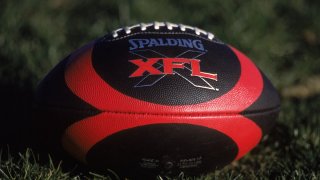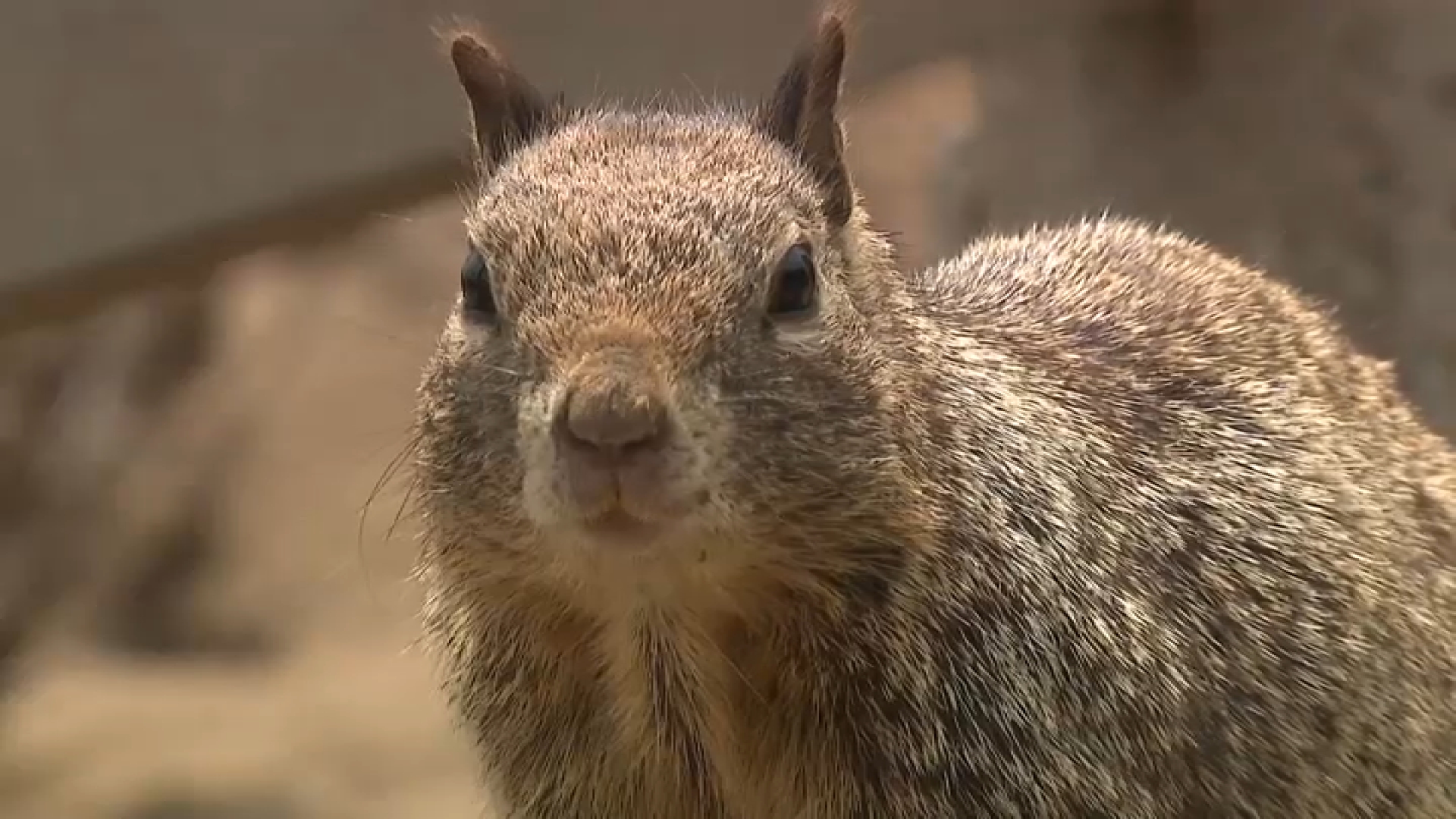
FILE PHOTO: A general view of the official XFL Football during the Los Angeles Extreme Training Camp at the Sam Boyd Stadium in Henderson, Nevada. Jeff Gross /Allsport
The Los Angeles Wildcats made their debut Saturday, visiting Houston to face the Roughnecks as wrestling impresario Vince McMahon's second attempt at creating an alternative football league begins play with two games.
Anyone who watched probably noticed a few differences from the NFL, but this version of the XFL is seeking to differentiate itself from the first one, which folded in 2001 following its lone season. That season was best remembered for giving players the option of putting nicknames on the backs of their jerseys, most famously Las Vegas Outlaws running back Rod Smart, who opted for He Hate Me.
"I told Vince that I think it's appropriate to have surnames on the back of the jersey so people know who the hell it is," XFL Commissioner Oliver Luck told City News Service.
XFL vs. NFL: The Rules Differences
The new version includes several rules differences from the NFL intended to create a faster-paced and safer game.
The XFL aims to play each game in under three hours, but with the same amount of plays. It will have a 25-second play clock that begins after the ball is spotted for the next play. The NFL has a 40-second play clock.
Outside of the last two minutes of each half, when a play ends out of bounds or on an incomplete pass, the game clock will be stopped until the ball is spotted. In the NFL, the clock stops after every out of bounds play until the referee re-spots the ball and on incomplete passes until the next play begins.
Local
Get Los Angeles's latest local news on crime, entertainment, weather, schools, cost of living and more. Here's your go-to source for today's LA news.
XFL teams will have two timeouts per half, one fewer than in the NFL. Halftime is 10 minutes, two minutes less than the NFL.
Another attempt to shorten the game is not allowing coaches to challenge an official's ruling. All plays are subject to review by the replay official.
The final two minutes of each half has been dubbed the "comeback period." On plays ending in the field of play, the clock will be stopped until the ball has been spotted and five seconds have been run off the clock. On out- of-bounds plays, the clock will stop until the ball is snapped.
Stopping the game clock after every play in the final two minutes of a half will give the trailing team the opportunity to maximize its remaining time and still be able to use its complete playbook, including runs or plays in the middle of the field.
If a team completes a pass behind the line of scrimmage, it can throw a second forward pass as long as the ball has not crossed the line of scrimmage.
Luck said his favorite rule difference is giving coaches the option of attempting a one-point conversion from the 2-yard line, a two-point conversion from the 5-yard line or a 3-point conversion from the 10-yard line after a touchdown. Kicks on conversion attempts are not allowed.
If the defense causes a turnover on a conversion attempt and is able to return the ball to the opponent's end zone, the resulting score is equal to the number of points the offense was attempting to score.
Several changes are being made to kickoffs, both attempting to reduce high-speed collisions and the resulting injuries but also encouraging more kickoff returns.
The kickoff will be from the 30-yard line, five yards behind the NFL spot. Kickers must kick the ball in the air and in play between the opponent's 20-yard line and the end zone.
The coverage team will line up on the return side 35-yard line and the return team on the 30-yard line. Each team must have exactly three players outside the hash marks on both sides of the ball and cannot move until the ball is caught by the returner.
Players can move when the ball is touched by the returner or three seconds after the ball touches the ground. Out-of-bounds kicks and kicks falling short of the 20-yard line will result in an illegal procedure penalty with the receiving team getting the ball on the kicking team's 45-yard line.
If the ball is kicked into the end zone and is downed, it is a "major" touchback, and the ball is placed on the return side 35-yard line.
Teams wishing to attempt an onside kick must indicate this to an official before the play. The teams will be permitted to line up using traditional NFL rules, 10 yards apart from the spot of the kick.
The XFL has a set of rule changes designed both to increase the percentage of punts that are returned and discourage punting inside the opponent's territory.
The punting team cannot release past the line of scrimmage until the ball is kicked. In the NFL, the end man on the line of scrimmage can cross the line of scrimmage once the ball is punted. Tests of the rule found an average distance of 11 yards between the punt returner and the nearest defender, five yards more than what happens under NFL rules, Luck said.
Punts going out of bounds inside the 35-yard line are considered a "major" touchback with the ball going to the 35-yard line, as are punts landing in the end zone or going out of the end zone.
If the score is tied at the end of regulation, overtime will be similar to penalty-kick shootouts in soccer or penalty-shot shootouts in the NHL.
Overtime shall consist of five rounds, staged in alternating single-play possessions. A round will consist of one offensive play per team. Each possession starts at the opponent's 5-yard line and the offensive team has one play to score. The team with more points after five rounds is the winner.
If teams are tied after five rounds, then rounds continue until one team is leading at the conclusion of a round. The overtime will end once a team has been mathematically eliminated.
Each scoring play in overtime will be worth two points. The defense cannot score in overtime.
One of the XFL's goals is to "try to provide as much access to the fan as we possibly can during the broadcast" including showing coaches as they speak to their teams, having officials wear microphones and allowing players to be interviewed during the game, Luck said.
"We're really focusing on audio because we think [it's] audio that fans can't get enough of," Luck said.
Coordinators, Coaches and Players
The member of the Wildcats organization most familiar to Los Angeles fans is offensive coordinator Norm Chow, USC's offensive coordinator from 2001-04, helping guide the Trojans to The Associated Press version of the national championship for the 2003 season and the Bowl Championship Series national championship the following season.
The Wildcats are coached by Winston Moss, who coached 20 seasons in the NFL, including as the Green Bay Packers associate head coach/linebackers coach from 2015-18. Moss was an NFL linebacker with three teams from 1987-97, including with the Los Angeles Raiders from 1991-94.
Charles Kanoff will start at quarterback for the Wildcats is place of Josh Johnson, who is sidelined because of a thigh injury. Kanoff is a former Harvard-Westlake School standout who played college football at Princeton. He was the Ivy League's offensive player of the year in 2017, when he set the conference record with 3,474 passing yards.
Kanoff has spent time on the practice squads of the Arizona Cardinals, Detroit Lions and Tampa Bay Buccaneers.
The 33-year-old Johnson is among players on the Wildcats active roster to have played in NFL regular-season games, including starting three games for the Washington Redskins in 2018.
Houston is coached by June Jones III, who coached the Atlanta Falcons to a 19-29 record from 1994-96. The Roughnecks starting quarterback will be P.J. Walker, who set career records at Temple University for victories by a starting quarterback, passing yards, passing touchdowns, completions and passes.
Walker was on the Indianapolis Colts practice squad for parts of the 2017 and 2018 seasons and two days in 2019.
A viewing party for the game's Fox telecast will be held 1-5 p.m. at The Dudes' Brewing Co., 1840 W. 208th St., in Torrance.
The Wildcats will play their first home game Feb. 16 at Dignity Health Sports Park in Carson against the Dallas Renegades.
The DC Defenders will play host to the Seattle Dragons in the league's first game earlier Saturday.



